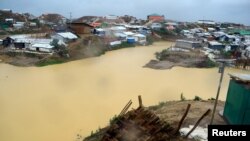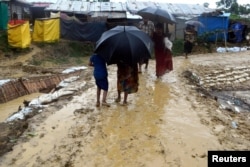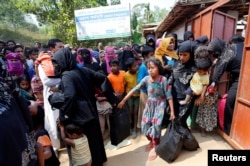Aid agencies report the first monsoons to hit Bangladesh are causing havoc in the Cox’s Bazar district, where nearly one million Rohingya refugees from neighboring Myanmar are living on barren hills in congested, fragile conditions.
The worst fears of humanitarian agencies are coming true. Their predictions that the monsoon season would have a devastating impact on the Rohingya settlements have come to pass. In recent days, the agencies report some 11,000 people have been affected by torrential rains that have caused heavy flooding and landslides in Cox’s Bazar.
The agencies report the rains and wind speeds of up to 70 kilometers per hour have caused torrents of mud and clay to slide down deforested hills, damaging and destroying shelters in their path. U.N. refugee agency spokesman Andrej Mahecic says several people have been injured and one child is confirmed dead.
“Given the scope of the refugee population, the sheer size of the settlements and the challenging terrain, we fear that the extreme weather will cause further damage, destruction and potential loss of life," he said. "Based on aerial mapping of the settlements, we estimate up to 200,000 refugees could be at risk of landslides and floods and still need to be moved to safer areas.”
The International Federation of Red Cross and Red Crescent Societies says access to some of the Rohingya camps has been cut off, making it difficult to assess the needs. Red Cross spokesman Matthew Cochrane says sodden and unstable hills have collapsed, destroying latrines and carrying sludge through the camps. He calls this a major concern.
“We are already seeing increases in acute watery diarrhea and the risk of an outbreak of waterborne diseases is now a serious likelihood," he said. "Obviously, this has been something that agencies have been warning since the beginning of the crisis and since the cusp of the storm season.”
Aid agencies are scaling up their operations. They say they are working around the clock to try to mitigate risks of landslides and flooding and to prevent injury and death in the highly congested refugee settlements.
Nearly 700,000 Rohingya fled to Bangladesh in August to escape mass violations and persecution in Myanmar. Hundreds of thousands of Rohingya from a previous exodus also are living in Cox’s Bazar.









